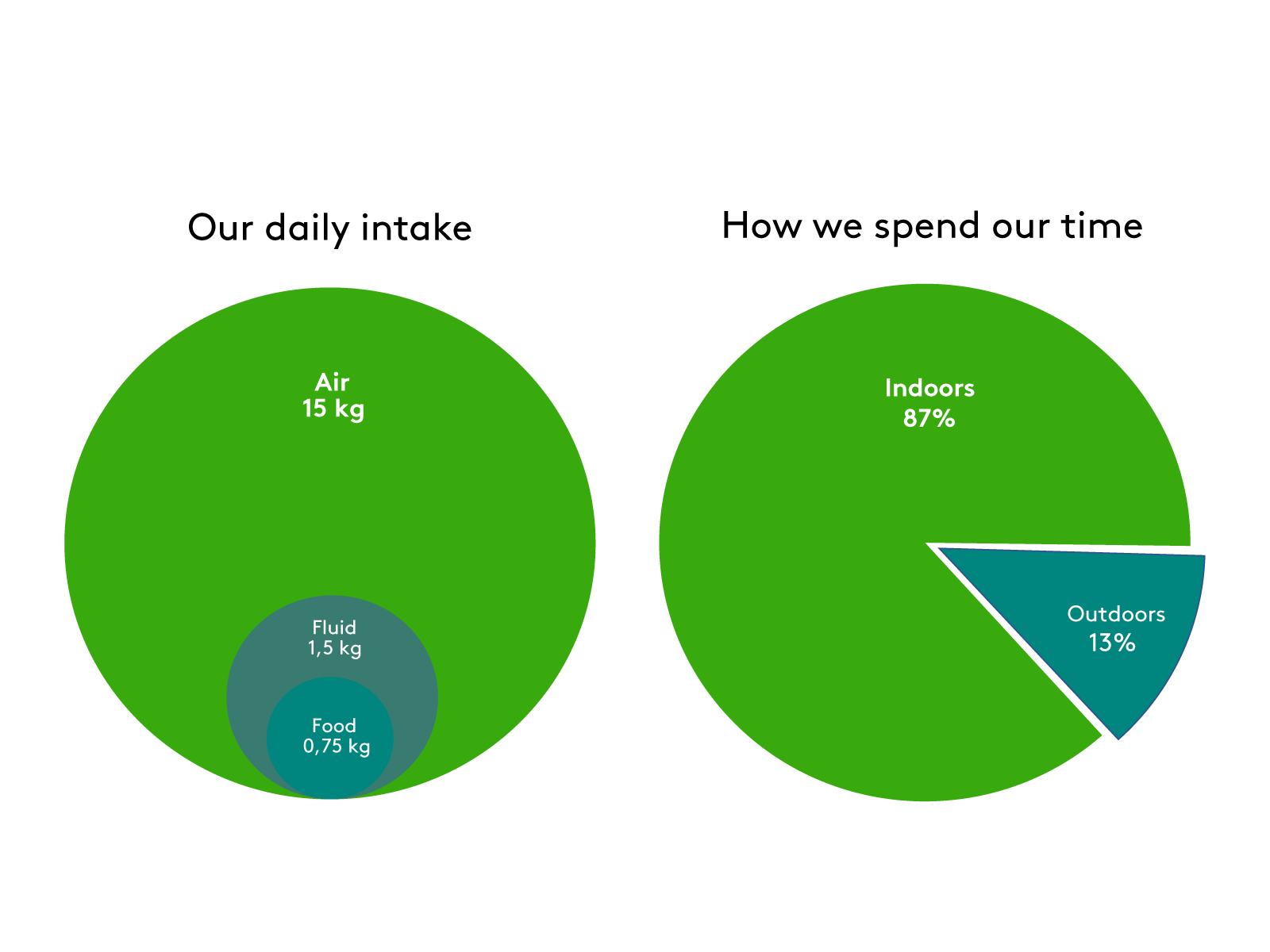The indoor climate matters
People in the industrialised parts of the world spend about 90% of their lives indoors. The indoor climate is therefore of great importance for comfort and well-being, and also because there is a strong link between a good indoor climate and productivity.
We spend 90% of our lives indoors
While we take great care about what we eat and drink to keep ourselves productive and healthy, we rarely give much thought to the air we breathe. The circular diagram to the right show that our indoor environments play a significant role in our lives. In modern society, we spend a lot of our time inside controlled environments which are disconnected from nature’s, sometimes vast, variations. This is a good thing when it’s stormy and pouring rain, but it does require indoor environments that maintain a high standard over time and that are designed to suit our needs as living human beings. 


The indoor climate affects our health
The most important aspect of our indoor climate is, of course, that it promotes good health. Many of the obvious health risks we once were exposed to have successively been eliminated, for instance fuming fireplaces and indoor smoking. But research shows that we are still adversely affected by our indoor environments, although in less obvious ways.
Poor air quality may, for instance, cause problems ranging from irritation of the eyes, nose and throat through to headache, tiredness and impaired concentration. Humidity levels in winter may be extremely low indoors, especially in Northern Europe, which poses increased risk of infection and virus transmission. Even noise, in the form of monotonous tones is known to cause long-term health problems in the form of tinnitus, heart disease and sleeping disorders. Our ancestors scarcely needed to think about harmful noise out in nature.
In summary, there is every reason for addressing the aspects of health and well-being when designing indoor environments.
Sources: Swegon, Technical Indoor Climate Guide, 2017 I World Health Organization, Burden of disease from environmental noise, 2011 I Sterling, Arundel, & Sterling, Criteria for human exposure to humidity in occupied buildings, 1985
Indoor environments for top performance
After designing optimal indoor enviroments from a health perspective, the indoor climate should also be considered in terms of top performance.
Careful measures are generally taken to maximise workplace efficiency and to provide conditions conducive to learning in schools, often by employing skilled teachers and use productive educational aids. In this process, it is of vital importance to also consider the impact of the indoor climate - a good indoor climate improve performance.


The importance of a good indoor climate at work
As said in the previous section, after addressing the health aspects of an indoor environment it is time for a productivity perspective. Many aspects are considered for workplace efficiency or increased learning in schools, but the indoor climate is rarely thought about. Temperatures that run too high or too low have a noticeable impact on productivity at work, and the link between air quality and capacity for strategic thinking or learning is well established. Research reveals that it is worth investing in a good indoor climate.
A study shows that as many as 33% of people report that ventilation affects their work capacity ‘quite a lot’ or ‘a great deal’. The same study also indicates that 57% rate their home ventilation as superior to the one at work, which should be a good incentive for investing in a solution for an optimal indoor climate in workplaces and schools.
Sources: Seppänen, Air, p. 60 I Allen, MacNaughton, Satish, Santanam, Vallarino & Spengler, Associations of Cognitive Function Scores with Carbon Dioxide, Ventilation, and Volatile Organic Compound Exposures in Office Workers: A Controlled Exposure Study of Green and Conventional Office Environments, Environmental Health Perspectives, National Institute of Environmental Health Sciences, 2015, USA I Bakó-Biró et al; Ventilation rates in schools and pupils’ performance, Building and environment 2011

